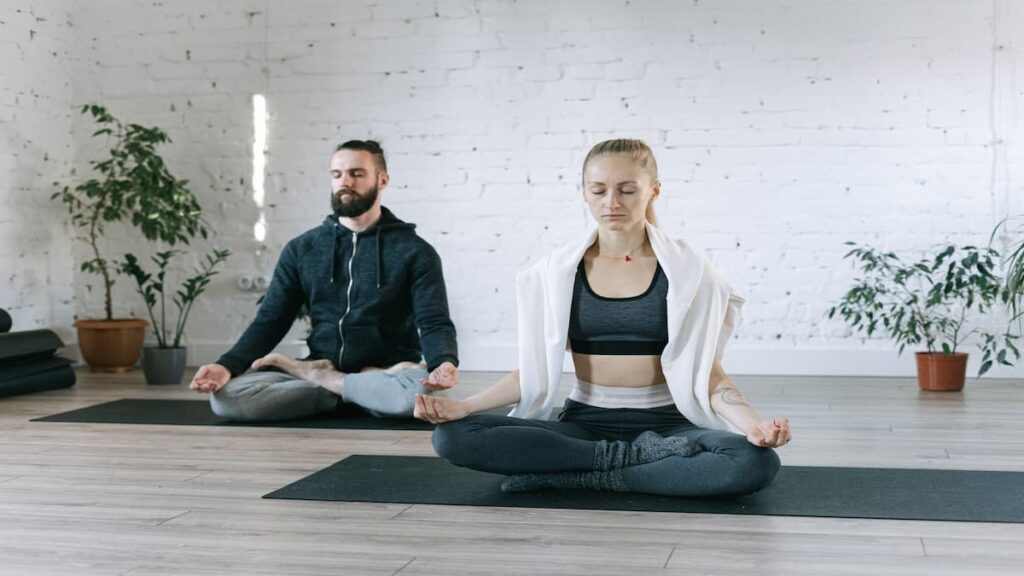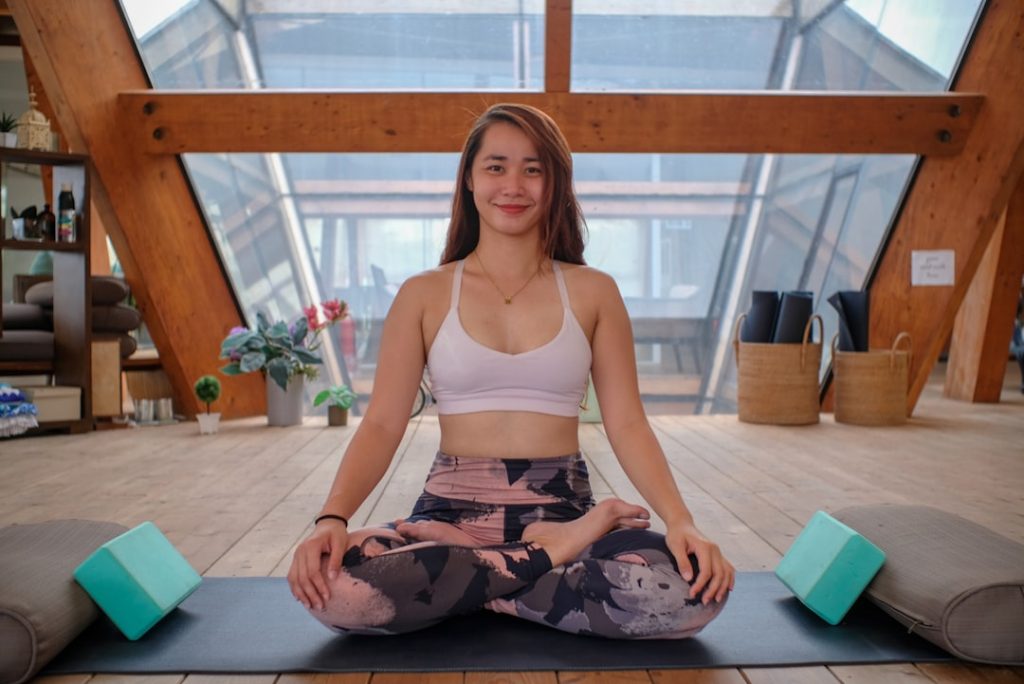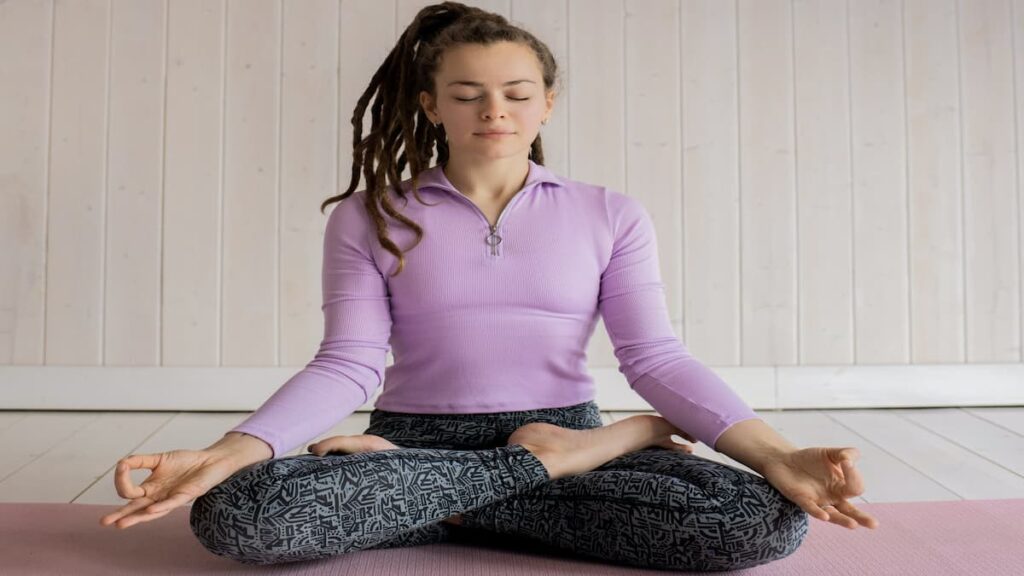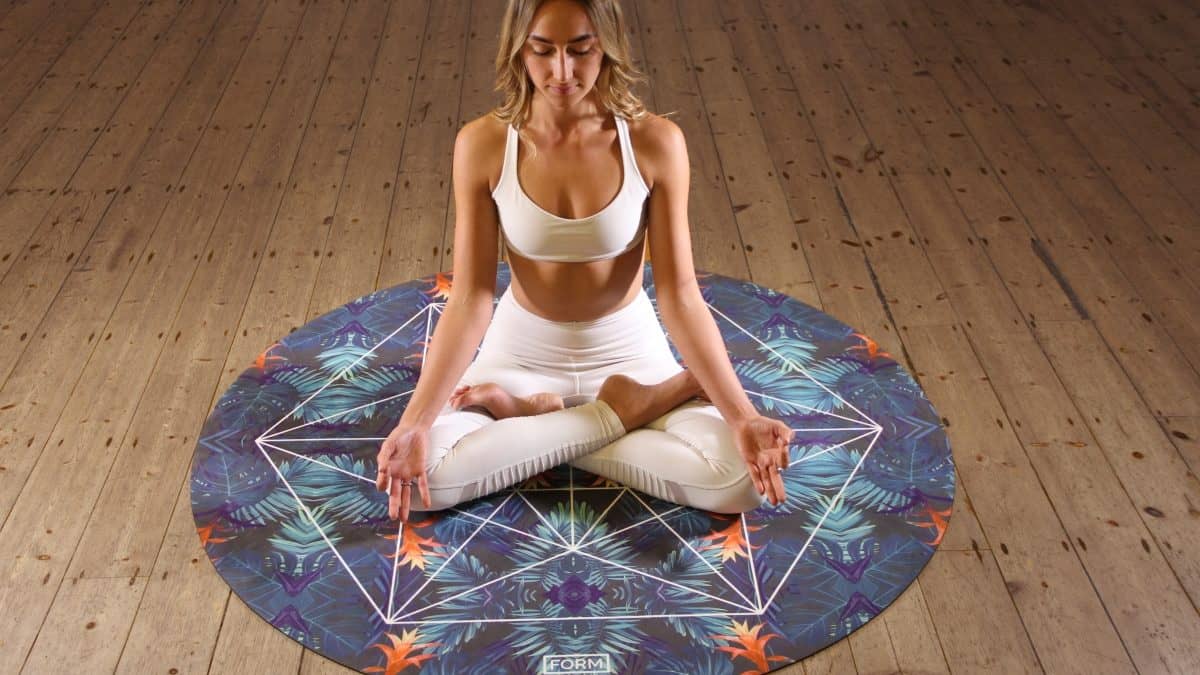Padmasana Yoga | Lotus Pose | Meaning, Steps, And Benefits
Introduction
Imagine finding a peaceful and serene space within yourself, where the chaos of the outside world doesn’t affect you. A place where your mind becomes clear and stress melts away. Many seek to get this state of calmness through the practice of yoga, specifically the Padmasana position.
This article will explore the art of unlocking serenity through mastering the Padmasana position, also known as the Lotus pose. It is a seated yoga pose that requires balance, flexibility, and focus. It is one of the basic positions for meditation and spiritual awakening. By sitting in this posture, one creates harmony between the body, mind, and spirit, ushering in a state of inner peace and mental clarity.

In this holistic guide, we will describe the details of the Padmasana sitting position – from its physical benefits to the steps to achieve it correctly. Whether you’re new to yoga or a seasoned yogi, this article will provide you with the knowledge and techniques to master it and unlock the gateway to peaceful introspection.
Get ready to embark on a journey of self-discovery and embrace the serenity that lies within.
Padmasana Information
| Pose Name | Padmasana Kamalasana |
| Sanskrit Name | पद्मासन |
| Internation Alphabets of Sanskrit Transcription (IAST) | padmāsana |
| English Name | Lotus Pose |
| Origin | Ancient, Traditional |
| Difficulty Level | Advanced |
| Type | Seated Posture Meditation Pose |
Padmasana Meaning
The term Padmasana has its roots in Sanskrit, where “Padma” translates to lotus, giving the English name “Lotus Posture.” This yoga position earned its name due to its resemblance to the unfolding petals of the lotus flower. In Sanskrit, it is also known as Kamalasana, giving an alternative name for this meditative pose deeply embedded in ancient yoga traditions. As yogis assume the Lotus Position, they emulate the graceful and serene unfolding of the lotus, creating a connection between the physical form and the symbolic significance of this revered flower in Eastern philosophy and spirituality.
Padmasana Position Origin and History
The history of the Padmasana spans centuries, evident in second-century CE statues of Buddha and Mahavira. Yoga Yajnavalkya, an early text predating the second century, outlines the steps for assuming this yoga pose. Maharishi Vyasa’s commentary on Yoga Sutra believed to be from the same era, further describes the significance of the Lotus Posture. Likewise, an intriguing artifact from the period of Chandragupta II (380 CE to 415 CE), a coin depicting a figure in this pose, reinforces its historical roots. These sources which span over 2,600 years, affirm the enduring practice and cultural resonance of this yoga pose, making it a timeless embodiment of yogic tradition and spiritual exploration.

Lotus Pose Procedure
Padmasana Position Precautions and Contra-Indications
The Lotus Pose is a highly respected yoga position; however, it may not be suitable for everyone. Hence, yogis need to be aware of precautions and contraindications to ensure a safe practice.
Knee or Ankle Issues
People who have knee or ankle injuries should refrain from taking this pose, as it places notable stress on these joints.
Hip Flexibility
Limited hip flexibility can make it difficult to perform Lotus Pose easily. It is better either to modify the pose or slowly work on improving hip flexibility before attempting the full version.
Recent Knee Surgery
Likewise, those who have recently had knee surgery or have a history of knee issues should avoid this pose to prevent strain and potential complexities.
Pregnancy
Similarly, pregnant women, mainly in later stages, should avoid this pose as it can compress blood vessels and nerves, potentially causing discomfort. It is advisable to choose alternative poses that are safe during pregnancy.
Lower Back Concerns
People with lower back issues should exercise caution when practicing this pose, as it may worsen existing problems. As such, supporting the back with props or opting for alternative poses can help alleviate strain on the lower back.
Avoid Forceful Entry
It is crucial to never force the legs into the Lotus position. Gradual progression and patience are key to preventing injury and strain on the joints.
Joint Pain
If yogis experience pain in the ankles, knees joints, or hips during the pose, it is important to immediately release the posture to avoid further injury.
It is advisable to consult with a qualified yoga instructor for specific health concerns or conditions. They can guide on modifications and alternative poses that can be tailored to specific needs, ensuring a safe and beneficial yoga experience.
Preparatory Poses for Padmasana Position
As we have already seen, the flexibility of hips and knee joints is the key to mastery over this yoga position. To open the hips, one should resort to the following warm-up yoga poses and practices.
- Easy Pose
- Head to Knee Pose
- Cow Face Pose
- Butterfly Pose
- Half Matsyendranath’s Pose
- Bound Angle Pose
- Half Lotus Pose
Padmasana Position Steps
Step 1
Firstly, sit on the floor with your legs stretched.
Step 2
Then, bend your left knee and place the foot on the other thigh so that the sole is placed as near the pelvic bone as possible.
Step 3
Similarly, bend the other leg and place the foot as in the previous step. Head and spine should be erect and be in a straight line and both your right and left knees should touch the ground.
Step 4
Next, place the hands on the knees in Jnana Mudra or Chin Mudra. Then, close the eyes and place the mind in between the eyebrows. Keep your breathing as slow as possible.
Important tip
After performing the posture with the left leg as mentioned in step 2, you should change the posture with the right leg. Alternatively, if you have used the right leg, you should change that to the left one. Because it gives balanced flexibility on the two sides. However, never force your legs into position. Stop at once if you feel any pain.
Duration
For a beginner, it is not possible to retain the pose for more than one or two minutes. Slowly the duration may be increased to three hours or more. The aspirant achieves mastery (Asana Siddhi) only when he can retain the posture for more than three hours. Once reached this milestone, it will be easier for him to proceed to the higher levels of yoga
Follow-up Asanas
After performing this yoga pose, one should resort to any one of the following postures.
Padmasana Position Benefits
The regular practice of this yoga pose gives the following benefits.

Lotus Pose Improves Meditative Stability
Lotus Pose extends beyond physical benefits, offering a great sense of stability and peace crucial for meditation and breath control practices. Also, the grounded posture creates a firm basis, allowing yogis to dive deep into meditation with a focused and calm mind. As the body aligns, the asana enhances mental clarity and emotional balance. This meditative stance not only strengthens the physical core but also serves as a gateway to spiritual progress. Also, the synchrony of body, breath, and mind in this pose creates a holistic approach to health, creating a serene space for inner reflection, mindfulness, and the journey toward self-discovery.
Padmasana Position Awakens Kundalini
Lotus Pose aids in awakening the Kundalini energy. Moreover, this ancient yogic concept involves the awakening of a dormant spiritual energy, often depicted as a coiled serpent, at the base of the spine. This seated and centered posture aids the upward movement of Kundalini energy through the spine’s energy centers (Chakras). As the energy ascends, yogis may experience elevated spiritual awareness, expanded consciousness, and a profound sense of inner awakening. Hence, its role in the Kundalini awakening underscores its significance as a potent tool for spiritual exploration and self-realization in yogic traditions.
Padmasana Position Increases the Power of Digestion
The seated position restricts blood circulation in the lower body, mainly the legs. This restriction, while seemingly counterintuitive, contributes to enhancing digestive power. Also, the reduction in blood flow prompts the digestive organs to function more efficiently, optimizing nutrient absorption and promoting digestive health. This limitation of blood circulation in the lower extremities, coupled with the meditative aspects, creates a holistic impact on the body. Yogis often find that this seated pose not only gives mental clarity but also plays a role in supporting a healthy digestive system, making it a useful addition to overall health.
Provides Progressive Relaxation When Combined with Breathing Exercises
Scientific studies examining this pose when combined with breath control practices reveal its impact on the nervous system. Also, this yoga pose has been found to activate the Parasympathetic Nervous System (PNS), eliciting a relaxation response. As the body assumes this seated and meditative position, the calming impact on the nervous system leads to a decrease in stress and anxiety levels. Thus, the activation of the PNS induces a state of deep relaxation, creating mental peace and emotional health. The findings underscore the therapeutic potential of the Lotus Pose, not only as a physical posture but as a powerful tool for promoting psychological resilience and mitigating the effects of stressors.
Lotus Position Improves Heart Health
TheLotus position serves as a conduit for progressive relaxation, intertwining the physical and mental realms to promote complete heart health. As yogis settle into the tranquil embrace of this pose, the deliberate focus on breath and intentional relaxation ripples through the entire being. This integrated approach culminates in a harmonious reduction of blood pressure and alleviation of palpitations. This progressive relaxation unfolds a therapeutic journey, offering a respite for the mind while extending its soothing effects to the cardiovascular system. The practice becomes a holistic embrace, nurturing a balanced and serene state that resonates with overall heart health.
Hip Flexibility and Spinal Alignment
The Padmasana offers multifaceted benefits by providing hip flexibility and spinal alignment. The posture involves a seated position that slowly enhances the range of motion in the hips, promoting flexibility. At the same time, the upright seated position boosts spinal alignment, reducing strain on the back and creating a strong, supportive posture. Regular practice of this pose nurtures physical health while also contributing to a sense of balance and harmony in the body. The duo of hip flexibility and spinal alignment makes it a valuable addition to yoga practices aimed at enhancing overall flexibility, strength, and postural integrity.
Padmasana Position Enhances the Flow of Subtle Energies
The impact of sitting on the body’s subtle energies is distinct. Sitting in a chair tends to diminish these energies, whereas adopting this posture exerts a universal energizing effect, albeit after approximately 20 minutes of practice. The intentional and meditative nature of this pose encourages the harmonious flow of subtle energies throughout the body, fostering a revitalizing influence. This contrast highlights the significance of mindful posture choices in influencing the body’s energy dynamics. As yogis embrace this yoga posture, they unlock great potential, experiencing an energized and balanced state that transcends the limits of more conventional seated positions.
Padmasana Position Gives Posture Correction
Lotus Pose is known for its impact on posture correction. As yogis assume this seated position, the spine naturally aligns itself, promoting an upright and balanced posture. The engagement of core muscles in maintaining the pose strengthens the back, shoulders, and neck. Over time, consistent practice of this pose contributes to increased body awareness, correcting slouching tendencies, and creating an improved overall posture. This intentional focus on alignment not only enhances the physical look but also supports the spine’s health, preventing discomfort and potential issues linked with poor posture. Thus, it stands as a basic pillar for cultivating a strong, balanced, and naturally aligned pose.
Padmasana Position Improves Focus and Concentration
Full Lotus Pose is a powerful catalyst for improving focus and concentration. By assuming a seated and balanced position, you establish a stable foundation that allows you to turn their attention inward. The Lotus Pose when combined with controlled breathing supports a calm and centered mental state, reducing distractions. As people engage in this meditative pose, their minds naturally gravitate towards mindfulness, resulting in elevated focus. Through regular practice, this pose becomes a valuable tool for enhancing cognitive abilities, sharpening focus, and cultivating the mental clarity necessary for tasks that require sustained attention and focus. As a result, it is a valuable addition to practices aimed at enhancing cognitive function and promoting mindfulness.
Padmasana Position Variants
The following yoga postures belong to the group Lotus posture.
- Ardha Padmasana (Half Lotus)
- Scale Pose
- Bound Lotus Pose
- Cockerel Pose
- Upward Lotus Pose
- Psychic Union Pose
Lotus Pose in Other Asanas
Apart from the variations of this posture, it is combined with other yoga postures.
- Lotus Peacock Pose
- The Lotus Head Stand
- Lotus Shoulder Stand and
- Lotus Lion Pose
Classical Yoga Texts
The earliest mention of this Posture was in the Yoga Sutra commentary by Maharishi Vyasa. Yoga Yajnavalkya also mentions this pose.
According to Yoga Yajnavalkya, this position is formed by placing both legs on opposite thighs and holding the big toes by the hands from behind.
Verse 559 of Thirumanthiram by Thirumoolar provides the steps to do this yoga pose.
The text says “In Sukhasana (easy pose), take your foot and place it on the opposite thigh in such way that your left leg on the right thigh and right leg on the left thigh and place your hands on them showing your palms up. This is known as the Lotus Position”.
Hatha Yoga Pradipika
Verses 1.44 to 1.49 of Hatha Yoga Pradipika describe this posture, its importance, and its benefits.
Place the right foot on the left thigh and the left on the right one and hold firmly the toes by the crossed hands from behind. Also, press the chin on the chest and look at the tip of the nose. This is the Lotus Posture that destroys all bodily diseases. (Verse 44).
Place the feet on the thighs soles facing up and place the hands on the groin with palms facing up. (Variation). Look at the tip of the nose. Keep pressing the tongue against the root of the upper teeth. Keep the chin firmly on the chest and raise the Vayu upwards. (Verses 45-46).
This pose destroys all physical ailments. It is not easy for all to master. Hence, only the intelligent attains it. (Verse 47).
Sit in the lotus pose. Place one palm on the other. Also, press the chin on the chest. Meditate on Him (The Supreme Entity). Then, draw Apana up and bring Prana down. Likewise, repeat again and again. Thus, one awakens Kundalini and attains the highest wisdom. (Verse 48).
The Yogi seated in this posture controls the Vayu by inhaling and filling. He attains liberation without any doubt. (Verse 49).
Siva Samhita
According to Verse 3.20, the yogi should go to a remote place or a cell, assume this Pose on the seat, and begin Pranayama practice.
Verses 3.88 to 3.91 describe this position more.
Here are the tips for performing the lotus posture that eliminates all diseases. Firstly, begin by sitting in a cross-legged position and placing your feet on the opposite thighs. Next, cross your hands and position them in the same manner, with palms facing upwards on your thighs. Direct your gaze towards the tip of your nose. Press your tongue against the upper teeth. Inhale slowly, filling your lungs to their maximum capacity, and exhale steadily and rhythmically. (verse 3.88).
It is not possible for everyone. Only the intelligent one gets mastery over it. (Verse 3.89).
By assuming this practice, the vital airs of the yogis at once get a stable equilibrium without any doubt and the airs flow harmoniously through the body. (Verse 3.90).
By sitting cross-legged in this posture and knowing the moves of Prana and Apana, the yogi who performs Pranayama attains liberation. I tell the truth. I tell the truth. (Verse 3.91).
Gheranda Samhita
Gheranda Samhita gives the procedure to perform this Pose as below.
Place the left foot on the right thigh and the right one on the left thigh. Cross the hands behind the back and catch hold of the big toes. Place the chin on the chest and gaze at the tip of the nose. This is the Lotus Pose that destroys all bodily ailments. (Verse 2.8).
Conclusion
It is important to highlight that most ancient Yoga texts, like Yoga Yajnavalkya, offer guidance on the different phases of Baddha Padmasana, commonly referred to as the Bound Lotus Pose, which is a modified version, and referred to as the Lotus Pose. So, it is not feasible for everyone to execute this posture exactly as described in the texts. Even attempting a simpler variation of this pose can prove to be extremely challenging for the majority of people.
